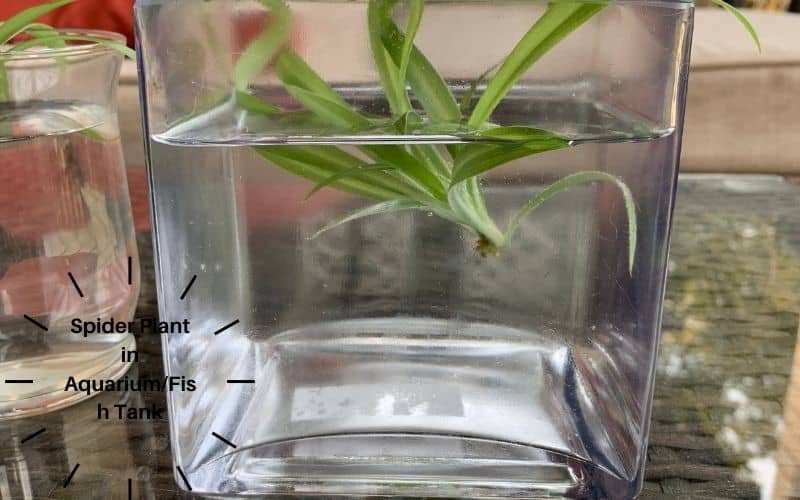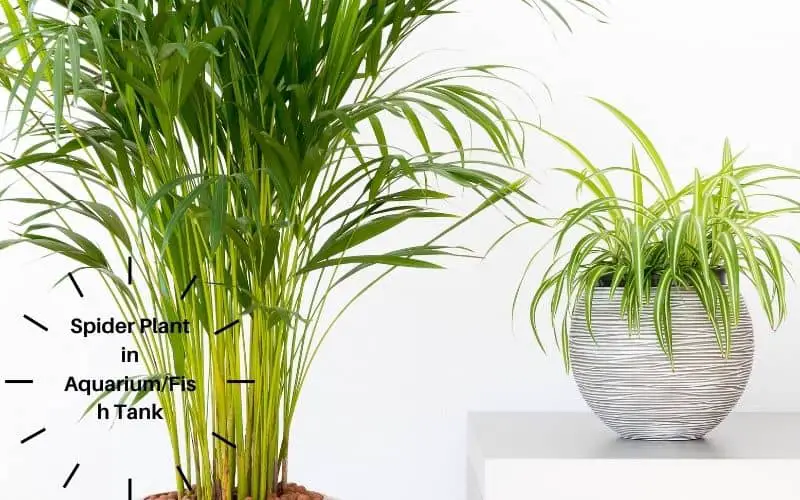The spider plant is a popular houseplant native to South Africa, and one of the easiest-to-grow trailing or hanging houseplants among gardeners. The spider plant belongs to the Lilly family and has long, narrow leaves with a central yellow stripe. so can I keep Spider Plant in Aquarium/Fish Tank?

Can You Grow Spider Plant in Water?
Jump To
You can grow Spider Plant in water with the necessary care. For the plant to propagate in the water, you have to submerge only the roots, not the foliage. You can grow Spider plants in Aquariums and Fish Tanks if you provide the plant’s water-related needs, fertilizers, space, climate, and other environmental conditions.
Can Spider Plants Live Underwater?
No. Spider plants can not live underwater. If the plant is entirely submerged, the leaves will rot, and the plant will die. The spider plant is actually a non-aquatic plant that is not native to underwater environments. Spider plants can live in the water if the foliages stay above the water. Soil is not necessary for spider plants to live.
Spider Plant in Aquariums
Unlike regular fish tanks, Aquariums are made out of living plants and marine animals. Usually, an aquarium has a higher water volume, controlled lighting, natural fertilizers, and a water aeration system that is ideal for spider plant propagation.
Just because it fulfills the nutrition requirements doesn’t mean that the Spider plant can thrive in an aquarium. It needs to be above the water, or else the plant will rot. You can keep the roots of the Spider plant in the water but do not submerge the leaves.
Pros and Cons
Pros
- Improves the look of your Aquarium
- Absorb nutrients in the water as fertilizers
- Helps maintain a stable temperature in the Aquarium
- Increases humidity of the environment
- Purifies the Air around the Aquarium
- Maintain healthy Oxygen and CO2 levels in combination with other aquarium plants
- An incorporated light and aeration system helps the healthy growth of the plant
Cons
- You need to implement a tray or other equipment to keep the foliage from gangling in the water
- Proper lighting and a water aeration system is essential for optimal growth
Will it Survive
The spider plant is a garden plant, not an aquatic plant. It is known as a hardy plant that can survive in various climatic conditions and water levels. Spider plants can usually thrive in an aquarium if their foliage doesn’t touch the water. Although the time frame is unknown, a spider plant can survive in an aquarium for a long time, given only the root is submerged.

Spider Plant in Fish Tank
Fish tanks are generally considered aquariums. However, fish tanks usually lack live aquarium plants and are smaller in size. They are decorated with rocks, gravel, fake plants, and other decorations.
Unlike aquariums, fish tanks have different amounts of Oxygen and CO2. When you incorporate a spider plant into the fish tank, the balance of Oxygen and CO2 can change, and it may be toxic for both your fish and plant.
However, if you provide a vigorous aeration system and proper lighting, you can grow a Spider Plant in your fish tank. Even in this case, the only part of the Spider Plant you want in the water is the root system.
Pros and Cons
Pros
- Increases humidity of the environment
- Purifies the air around the fish tank
- Act as a natural decoration for your tank
- It helps maintain the temperature levels stable
- Absorbs fish poop as fertilizers
Cons
- Without other aquarium live plants, it can imbalance the Oxygen and CO2 levels
- Proper lighting and aeration are a must
Will it Survive
The surviving rate of the Spider Plant in a fish tank is similar to the Aquarium. However, if a proper aeration system is not provided, there’s a risk for other species in the tank because of the gas imbalance the plant makes in the water. So, if you want both the plant and your fish to live happily, you must provide proper aeration and lighting system.
Read more Can I Use Outdoor Gravel Or Rocks In an Aquarium?
How to Grow Spider Plants in Water
Now you know that spider plants can be grown in the water. But, do you know the requirements for Spider Plant to thrive in the water? There are four factors you should consider when growing Spider Plants in the water.
- Water
- Light
- Temperature
- Fertilizers
Let’s talk about each requirement below.
Water Requirements
Spider plants need fresh water to grow. So, they will survive in only freshwater aquariums that are well-aerated and rich in Nitrogen. When you put a spider plant into your Aquarium or fish tank, you should keep in mind that they need enough oxygen, CO2, and lighting to perform photosynthesis.
Aquariums and Fish tanks are usually equipped with an aeration system to replenish the tank’s used oxygen. When you submerge only the plant roots (which you should), the roots will release CO2 to the waters instead of the foliages, which produce oxygen. If the Aquarium contains aquatic plants that absorb CO2 and release O2, the oxygen and CO2 levels get balanced naturally. If not, the water will have excessive CO2 eventually, and it can cause both the plant and marine animals in the Aquarium to die. That is why you should include an aeration system in your Aquarium or fish tank.
Light Requirements
Spider plants, irrespective of what medium they are cultivated in need enough light to survive. They can tolerate shade for some time but need lit environments mostly. That is why you should keep a lighting system in your Aquarium.
If you plan to provide natural sunlight, there are some things to consider. The spider plant can thrive in low light and part sunlight but can not survive for a long time with direct sunlight. That is because they lack in waxy coating of leaves to protect them from direct sunlight. Therefore, you’ll need to provide some shade to your Aquarium if you keep it outside.
Temperature Requirements
Spider plants are highly adaptable to various climate conditions. They can tolerate temperatures as low as 35°F and as high as 90°F. They can even bear temperatures below 65°F, but they will not grow much with that temperature. At temperatures above 90°F, the plant will increase the transpiration rate and increase the uptake of potentially toxic micronutrients.
Therefore, when balancing your Aquarium’s temperature levels, you should concentrate on your fish’s temperature requirement than the Spider Plant.
Fertilizer Requirements
Spider plants need fertilizers for their proper growth. However, they can thrive on any fertilizers available. In a well-kept aquarium, they can flourish well because the fish excrements and waste food work as excellent fertilizers for spider plants. However, if your tank is too small, you may need to put some general, water-soluble fertilizer for your spider plant.
Pesticides of Spider Plant
Many spider plants come from greenhouses, where they are sprayed with pesticides and insecticides. These chemicals can harm the entire ecosystem of your Aquarium. So, if you plan to put a spider plant into your Aquarium, ensure that the plant is free of pesticides and other chemicals.
Benefits of Spider Plant in Your Aquarium
The spider plant is a low-maintenance houseplant that can grow in soil or water with careful management of the foliages. It can act as a decoration for your Aquarium. However, growing a spider plant in an aquarium has many benefits for humans. Below are several benefits of the Spider plant for humans.
Purifies the Air
The spider plant is considered one of the easiest air-purifying plants you can grow. It can effectively remove harmful chemicals from the air, such as carbon monoxide, xylene, formaldehyde, and toluene. Formaldehyde is a chemical generally found in manufactured wood products, adhesives, leather goods, plastic products, pesticides, clothing, drapes, etc. According to NASA reports, the spider plant is one of the top 3 types of houseplants that can remove formaldehyde from the air.
Safe for Pets
The American Society for the Prevention of Cruelty of Animals (ASPCA) lists the Spider plant as a safe plant for pets. But they still advise keeping the pets out of this plant and not letting them eat this plant because it contains chemical compounds that are said to be related to opium. Opium may give your pet an upset stomach, vomiting, or diarrhea. However, the spider plant is listed as non-toxic for pets.
Speedy Recovery of Patients
Some research concludes that spider plants kept in hospital rooms speed up surgical patients’ recovery rate compared to the patients who stayed in rooms without the plant. The patients who stay behind Spider plants need less pain medication, do not suffer from heart rate issues or blood pressure problems, and suffer less anxiety and depression issues while recovering.
Increases Humidity
Spider plants can live for several years and have a high transpiration rate. The spider plant absorbs water through its roots. When you keep a spider plant in an aquarium or a tank, it gets an unlimited amount of water. It circulates the water through stems and leaves, and once the water reaches the leaves, it evaporates into the air; because of this process of transpiration, the environment humidity increases.
In increased humidity conditions, you will be less likely to have several airborne diseases, such as cold, sore throat, cough, and flu-like symptoms.
Spider Plants Common Problems in Aquarium
Sometimes you’ll notice changes in your spider plant in your Aquarium. You may see yellow or brown spots in your plant after some time. Find out why they are discoloring and how to fix them below.
Why Is My Spider Plant Turning Yellow?
If your spider plant is turning pale or yellow, it is most likely that your plant is not getting enough light. In this case, you’ll have to move your spider plant near your lighting system. If you keep your Aquarium outside, you’ll have to move the plant somewhere where it gets plenty of bright, indirect light.
Why Is My Spider Plant Turning Brown?
If your Spider plant’s leaves in your Aquarium turn brown, it is because of one of these two things.
- Water in your tank has high chlorine levels
- It is getting too much direct sunlight
If your tank or Aquarium is kept inside with artificial lighting conditions, your water has a high chlorine level. Although it is unlikely to happen, your fish may also suffer from chlorine. Dechlorinating your tank can fix this problem.
If your Aquarium is kept outside, you will have to provide some shade to your Aquarium.
Credits to H2O Plants
Read more Aquascaping Advanced Guide-Learn Professional Aquascaping
Read more Is It Safe To Put Dried Bamboo In An Aquarium? | Steps to Follow

